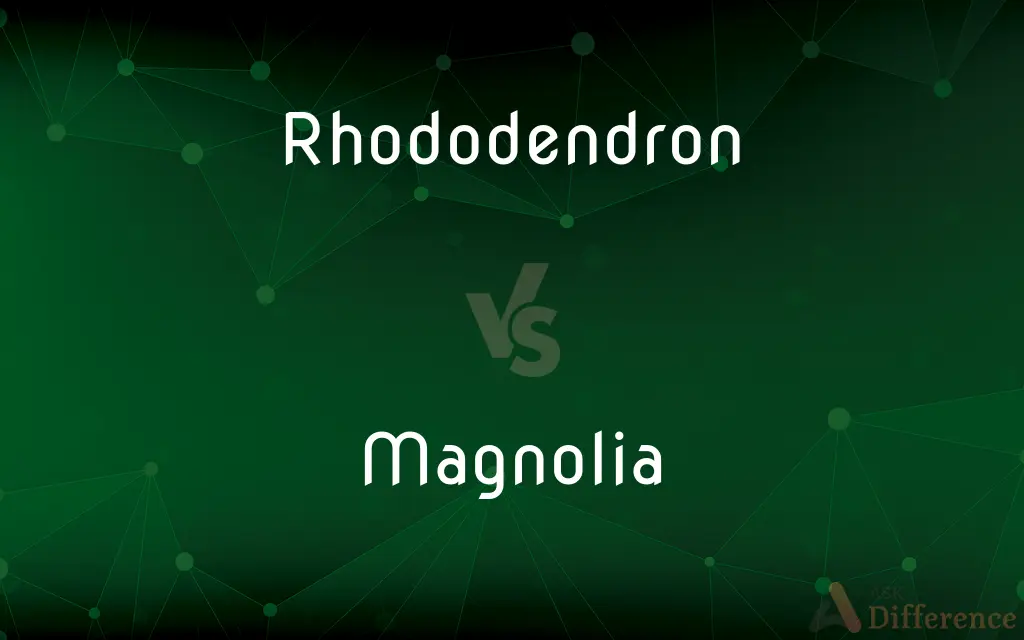Rhododendron vs. Magnolia — What's the Difference?
Edited by Tayyaba Rehman — By Urooj Arif — Updated on March 28, 2024
Rhododendrons are known for their evergreen foliage and clusters of bell-shaped flowers, while magnolias are celebrated for their large, aromatic blooms and broadleaf foliage.

Difference Between Rhododendron and Magnolia
Table of Contents
ADVERTISEMENT
Key Differences
Rhododendrons are a diverse group of plants, often evergreen, that thrive in acidic soils and cooler climates, bearing clusters of bell-shaped flowers in a variety of colors. Magnolias, on the other hand, are distinguished by their large, fragrant flowers that appear before the leaves in some species, and can thrive in both acidic and neutral soils, often preferring warmer climates.
While rhododendrons are renowned for their dense, green foliage that provides year-round interest, especially in temperate regions, magnolias offer seasonal interest with their impressive blooms that range from white to pink and purple, followed by the lush green of their broad leaves. This contrast in foliage and flowering times adds distinct characteristics to each plant.
Rhododendrons typically require well-drained, moist acidic soils and benefit from protection against strong winds and direct sunlight. Conversely, magnolias are more versatile, growing well in full sun or partial shade and often adaptable to a wider range of soil types, although they also prefer well-drained, moist conditions.
The size of rhododendrons can vary from small, bushy shrubs to large trees, making them highly versatile in landscape design, suitable for borders, woodland gardens, and as specimen plants. Magnolias, while also varying in size, are often larger and more tree-like, making them striking specimen trees that can dominate a landscape with their size and the visual impact of their flowers.
Comparison Chart
Flowering
Clusters of bell-shaped flowers.
Large, solitary, aromatic flowers.
ADVERTISEMENT
Foliage
Mostly evergreen, dense.
Deciduous or evergreen, broadleaf.
Soil Preferences
Acidic, well-drained, moist.
Versatile, prefers well-drained, moist.
Climate Preferences
Cooler climates, partial shade.
Warmer climates, tolerates more sun.
Landscape Use
Borders, woodland gardens, specimen plants.
Specimen trees, focal points in gardens.
Size
Varies from shrubs to large trees.
Often larger, tree-like.
Maintenance
Regular watering, mulching, occasional pruning.
Regular watering, mulching, less frequent pruning.
Compare with Definitions
Rhododendron
Prefers acidic soils and partial shade.
Rhododendrons thrive under the canopy of tall trees.
Magnolia
Adaptable to a range of soils, prefers full sun to partial shade.
A magnolia tree was planted on the south side to catch the sun.
Rhododendron
Requires moist, well-drained soil to flourish.
He amended the soil with peat moss for his rhododendrons.
Magnolia
Less frequent pruning required.
The magnolia tree grew tall and healthy with minimal interference.
Rhododendron
A genus of woody plants with bell-shaped flowers and mostly evergreen leaves.
The rhododendron in her garden bloomed profusely in spring.
Magnolia
A genus of trees or shrubs known for large, fragrant flowers.
The magnolia tree became the centerpiece of the new park.
Rhododendron
Varied in size and color, offering extensive landscaping options.
Dwarf rhododendrons are perfect for small gardens.
Magnolia
Offers dramatic visual impact in landscapes.
The large, white flowers of the magnolia were visible from across the street.
Rhododendron
Known for vibrant flowers and dense foliage.
The landscaper added rhododendrons for year-round greenery.
Magnolia
Blooms early, often before leaves appear.
The magnolia's blossoms signaled the first sign of spring.
Rhododendron
Rhododendron (; from Ancient Greek ῥόδον rhódon "rose" and δένδρον déndron "tree") is a very large genus of 1,024 species of woody plants in the heath family (Ericaceae). It is either evergreen or deciduous and found mainly in Asia, although it is also widespread throughout lowland and montane forests in the Pacific Northwest, California, the Northeastern United States, and especially in the highlands of the Appalachian Mountains of North America.
Magnolia
Magnolia is a large genus of about 210 flowering plant species in the subfamily Magnolioideae of the family Magnoliaceae. It is named after French botanist Pierre Magnol.
Rhododendron
Any of numerous usually evergreen shrubs of the genus Rhododendron of the heath family, having clusters of variously colored, often bell-shaped flowers and widely grown as ornamentals.
Magnolia
Any of numerous evergreen or deciduous trees and shrubs of the genus Magnolia of the Western Hemisphere and Asia, having large, showy, often fragrant white, pink, purple, or yellow flowers, and widely cultivated as ornamentals.
Rhododendron
(obsolete) Oleander (Nerium oleander).
Magnolia
The flower of any of these plants.
Rhododendron
Any of various flowering shrubs in the genus Rhododendron, especially
Magnolia
A tree or shrub in any species of the genus Magnolia, many with large flowers and simple leaves.
Rhododendron
(UK) Pontic rhododendron, common rhododendron (Rhododendron ponticum)
Magnolia
The flower of a magnolia tree.
Rhododendron
A genus of shrubs or small trees, often having handsome evergreen leaves, and remarkable for the beauty of their flowers; rosebay.
Magnolia
A native or resident of the American state of Mississippi.
Rhododendron
Any shrub of the genus Rhododendron: evergreen shrubs or small shrubby trees having leathery leaves and showy clusters of campanulate (bell-shaped) flowers
Magnolia
A creamy white colour, like that of some magnolia flowers.
Magnolia
Of a creamy white colour, like that of some magnolia flowers.
Magnolia
A genus of American and Asiatic trees, with aromatic bark and large sweet-scented whitish or reddish flowers.
Magnolia
Dried bark of various magnolias; used in folk medicine
Magnolia
Any shrub or tree of the genus Magnolia; valued for their longevity and exquisite fragrant blooms
Common Curiosities
Are rhododendrons or magnolias better for small gardens?
Dwarf varieties of rhododendrons are more suited for small gardens due to their compact size, while magnolias, generally larger, are better as focal points in larger spaces.
Can rhododendrons and magnolias grow in the same type of soil?
Both prefer well-drained, moist soil, but rhododendrons require acidic conditions, whereas magnolias are more adaptable to different soil pH levels.
What are magnolias?
Magnolias are a genus of trees and shrubs celebrated for their large, aromatic flowers and broadleaf foliage, either deciduous or evergreen.
What climate is best for growing magnolias?
Magnolias thrive in warmer climates and can tolerate more sunlight than rhododendrons.
What are rhododendrons?
Rhododendrons are a genus of evergreen or deciduous plants known for their clusters of bell-shaped flowers and dense, green foliage.
What climate is best for growing rhododendrons?
Rhododendrons prefer cooler climates and are more tolerant of shade.
How do rhododendrons and magnolias differ in their flowering?
Rhododendrons produce clusters of smaller flowers, while magnolias are known for their solitary, larger, and fragrant blooms.
Do magnolias produce fruit?
Yes, magnolias produce seed cones or fruit that can add interest to the garden after flowering.
How long do magnolia trees live?
Magnolia trees can live for 100 years or more, making them a long-lasting addition to landscapes.
Do rhododendrons require a lot of sunlight?
Rhododendrons generally prefer partial shade and can suffer from too much direct sunlight.
Can rhododendrons be used as hedge plants?
Yes, rhododendrons are often used as hedge or border plants due to their dense foliage.
Are rhododendrons toxic?
Yes, parts of rhododendrons are toxic to humans and animals if ingested.
Share Your Discovery

Previous Comparison
Heroine vs. Villain
Next Comparison
Neoprene vs. PVCAuthor Spotlight
Written by
Urooj ArifUrooj is a skilled content writer at Ask Difference, known for her exceptional ability to simplify complex topics into engaging and informative content. With a passion for research and a flair for clear, concise writing, she consistently delivers articles that resonate with our diverse audience.
Edited by
Tayyaba RehmanTayyaba Rehman is a distinguished writer, currently serving as a primary contributor to askdifference.com. As a researcher in semantics and etymology, Tayyaba's passion for the complexity of languages and their distinctions has found a perfect home on the platform. Tayyaba delves into the intricacies of language, distinguishing between commonly confused words and phrases, thereby providing clarity for readers worldwide.














































